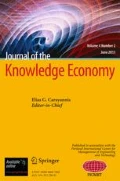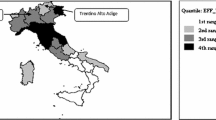Abstract
The centralised regime and variation of resources have led persistent regional disparities in Indonesia. Presently, there is lack of study that examines the impact of agglomeration economies and technology of firm establishment on regional growth in Indonesia. This paper applies agglomeration economies, approximated using proxy variables of concentration of four largest sectors (CR4), specialisation (LQ), diversity (DIV) and competition (COM) variables and technological capacity, approximated by total factor productivity (TFP), to explain the impact of firm establishment on economic growth. The paper found that districts with less specialisation and more advance technology would have higher economic growth. The paper recalls the importance of higher share of high-tech industry and a more spatial dispersion of industry to accelerate economic growth.
Similar content being viewed by others
Notes
Technology readiness index refers to the market-ready level of a technology product. Please see Mankins (1995).
This is done using STATA’s built-in ‘collapse’ command, and the level of TFP of districts is simply the mean value of plants’ TFP within the district.
References
Akita, T., Kurniawan, P. A., & Miyata, S. (2011). Structural changes and regional income inequality in Indonesia: A bidimensional decomposition analysis. Asian Economic Journal, 25(1), 55–77.
Aminullah, E. (2000). The dynamics of industrial technological capability in Indonesian economic development, Proceedings of ICSTM2000: International Conference on Systems Thinking in Management.
Amiti, M., & Konings, J. (2007). Trade liberalisation, intermediate inputs and productivity: Evidence from Indonesia. American Economic Review, 97(5), 1611–1638.
Aritenang, A. F. (2016). The Impact of State Restructuring on Indonesia’s Regional Economic Convergence, ISEAS Publication.
Aritenang, A. F. (2013). The role of technology in regional development: TFP and econometrics analysis. Journal of Indonesian Economy and Business, 28(1), 149–158.
Aritenang, A. F. (2020). The effect of intergovernmental transfers on infrastructure spending in Indonesia. Journal of the Asia Pacific Economy.
Aritenang, A. F., & Sonn, J. S. (2018). The effect of decentralization and free trade agreements on regional disparity in a developing economy: the case of Indonesia, 1993–2005. International Journal of Urban Sciences, 22(4), 546–564.
Barro, R. J., & Sala-i-Martin, X. (1991). Convergence across states and regions. Brookings Papers on Economic Activity, 22, 107–182.
Barro, R. J. (2015). Convergence and Modernisation. Econ J, 125, 911–942. https://doi.org/10.1111/ecoj.12247.
Boix-Domenech, R., Hervás-Oliver, J. L., & De Miguel-Molina, B. (2015). Micro-geographies of creative industries clusters in Europe: From hot spots to assemblages. Papers in Regional Science, 94, 753–772.
Booth, A. (2003). Decentralisation and poverty alleviation in Indonesia. Environment and Planning C: Government and Policy, 21(2), 181–202.
Busom, I., & Velez-Ospina, J. A. (2017). Innovation, public support, and productivity in Colombia. A Cross-Industry Comparison. World Development, 122, 245–260.
Daumal, M., & Özyurt, S. (2011). The Impact of International Trade Flows on the Growth of Brazilian States, DIAL Working Papers, Développement, Institutions & Analyses de Long terme: Paris.
Dias, S. (1991). Factors affecting the productivity of manufacturing sector in Sri Lanka: a spatial analysis. GeoJournal, 23, 113–120.
Driscoll, J. C., and Kraay, A. C. (1998). Consistent Covariance Matrix Estimation with Spatially Dependent Panel Data. Review of Economics and Statistics 80, 549–560.
Drucker, J. (2011). Regional industrial structure concentration in the United States: Trends and implications. Economic Geography, 87, 421–452.
Drucker, J., & Feser, E. (2012). Regional industrial structure and agglomeration economies: An analysis of productivity in three manufacturing industries. Regional Science and Urban Economics, 42(1–2), 1–14.
Fahmi F. Z., Koster S., Dijk J. V. (2016). The location of creative industries in a developing country: The case of Indonesia. Cities 59, 66e79.
Fan, C. C., & Scott, A. J. (2003). Industrial agglomeration and development: a survey of spatial economic issues in East Asia and a statistical analysis of Chinese regions. Economic Geography, 79(3), 295–319.
Firman, T. (2002). Urban development in Indonesia, 1991-2001: From the boom to the early reform era through the crisis. Habitat International, 26(2), 229–249.
Fujita, M., Krugman, P. R. & Venables, A. J. (2001). The spatial economy, MIT Press.
Glaeser, E. L., Kallal, H. D., Scheinkman, J. A., & Shleifer, A. (1992). Growth in cities. Journal of Political Economy, 100(6), 1126–1152.
Gömleksiz, M., Şahbaz, A., and Mercan, B. (2017). "Regional Economic Convergence in Turkey: Does the Government Really Matter for?," Economies, MDPI, Open Access Journal, vol. 5(3), pages 1–16, July.
Henderson, V., Kuncoro, A., & Turner, M. (1995). Industrial development in cities. Journal of Political Economy, 103, 1067–1090.
Henderson, V. (2003). Marshall’s scale economies. Journal of Urban Economics, 53, 1–28.
Hill, H. (2000). The Indonesian Economy 2nd ed., Cambridge University Press.
Hill, H., & Tandon, P. (2010). ‘‘Innovation and Technological Capability in Indonesia,’. World Bank.
Hill, H. (2014). An introduction to the issues in Hall Hill (Ed) Regional Dynamics in a Decentralized Indonesia. Singapore: ISEAS Publication.
Hirschman, A. O. (1957). The strategy of economic development. Yale University Press.
He, C., & Wang, J. (2012). Regional and sectoral differences in the spatial restructuring of Chinese manufacturing industries during the post-WTO period. GeoJournal, 77, 361–381.
Hu, C., Xu, Z., & Yashiro, N. (2015). Agglomeration and productivity in China: Firm level evidence. China Economic Review, 33, 50–66.
Hudalah, D., Viantari, D., Firman, T., & Woltjer, J. (2013). Industrial land development and manufacturing deconcentration in Greater Jakarta. Urban Geography.
Hudalah, D. & Aritenang, A. (2017). Industrial economies on the edge of Southeast Asian metropoles: from gated to resilient economies in Andrew McGregor, Lisa Law, Fiona Miller (Eds) Routledge Handbook of Southeast Asian Development. London: Routledge.
Indraprahasta, G. S., & Derudder, B. (2019). The geographically variegated connections of the Jakarta metropolitan area as produced by manufacturing firms. Growth and Change., 00, 1–20.
Kartodihardjo, H., & Jhamtani, H. (2006). Politik Lingkungan dan Kekuasaan di Indonesia. Jakarta: Ford Foundation, Equinox.
Khoirunurrofik. (2018). Local economic structure, productivity growth, and industry life cycle: evidence from Indonesia. Asia-Pac J RegSci, 2, 453–475.
Klein, M. A. (2019). Establishment productivity convergence and the effect of foreign ownership at the frontier. World Development, 122, 245–260.
Kuncoro, M. (2001). Regional clustering of Indonesia’s manufacturing industry: A spatial analysis with geographic information system (GIS). Gajah Mada International Journal of Business, 3(3), 269–295.
Kuncoro, M. (2002). AnalisisSpasialdan Regional. Yogjakarta: UPP AMP YKPN Press.
Kuncoro, A. (2012). Globalisation and Innovation in Indonesia: Evidence from Micro-data on Medium and Large Manufacturing Establishments, ERIA Discussion Paper Series.
Lazzeretti, L., Boix, R., & Capone, F. (2008). Do creative industries cluster? Mapping creative local production systems in Italy and Spain. Industry and Innovation, 15(5), 549–567.
Levinsohn, J., & Petrin, A. (2003). Estimating production functions using inputs to control for unobservables. Review of Economic Studies, 70(2), 317–341.
Lucas, R. E. (1988). On the mechanics of economic development. Journal of Monetary Economics, 22, 3–42.
Mankins, J. C. (1995). Technology readiness levels: A white paper. Office of Space Access and Technology, NASA: Advance Concepts Office.
Martin, P., Mayer, T., & Mayneris, F. (2011). Spatial concentration and plant-level productivity in France. Journal of Urban Economics, 69(2), 182–195.
Meijers, E. J., & Burger, M. J. (2010). Spatial structure and productivity in US metropolitan areas. Environment and Planning A: Economy and Space, 42(6), 1383–1402.
McCulloch, N. & Sjahrir, B. S. (2008). Endowments, location or luck? evaluating the determinants of sub-national growth in decentralised Indonesia, The World Bank.
Myrdal, G. (1957). Economic theory and under-developed regions, G. Duckworth & Co.
Nakamura, R., & Paul, C. J. M. (2009). Measuring agglom-eration. In Handbook of Regional Growth and Development Theories, Capello, R. and Nijkamp, P. (Eds), Edward Elgar, Cheltenham, pp. 305–28
Negara, S. D., & Adam, L. (2012). Foreign direct investment and firms’ productivity level: Lesson learned from Indonesia. ASEAN Economic Bulletin, 29(2), 116–127.
Nehru, V. (2013). Manufacturing in India and Indonesia: performance and policies. Bulletin of Indonesian Economic Studies, 49(1), 35–60.
Pepinsky, T. B., & Wihardja, M. M. (2011). Decentralization and economic performance in Indonesia. Journal of East Asian Studies, 11, 337–371.
Perroux, F. (1950). Economic space: Theory and applications. The Quarterly Journal of Economics, 64(1), 89–104.
Pike, A., Rodriguez-Pose, A. & Tomaney, J. (2006). Local and Regional Development 1st ed., Routledge.
Prihawantoro, S., Hutapea, R., dan Suryawijaya, I. (2012). Peranan Teknologi dalam Pertumbuhan Ekonomi Indonesia: Pendekatan Total Factor Productivity, BPPT.
Qvortrup, L. (2010). The new knowledge regions: from simple to complex innovation theory in Philip Cooke & Andrea Piccaluga (Eds) Regional Development in the Knowledge Economy, Routledge Regions and cities series: Oxon, UK.
Ramstetter, E. D., & Narjoko, D. (2014). Ownership and Energy Efficiency in Indonesian Manufacturing. Bulletin of Indonesian Economic Studies 50(2), 255–76.
Resosudarmo, B. P., & Vidyattama, Y. (2006). Regional income disparity in Indonesia: A panel data analysis. ASEAN Economic Bulletin, 23(1), 31–44.
Rigby, D. L., & Essletzbichler, J. (2002). Agglomeration economies and productivity differences in US cities. Journal of Economic Geography, 2, 407–432.
Rodríguez‐Pose, A., & Hardy, D. (2017). Firm competitiveness and regional disparities in Georgia. Geographical Review, 107(2), 384-411. https://doi.org/10.1111/j.1931-0846.2016.12180.x
Romer, P. M. (1986). Increasing returns and long run growth”. Journal of Political Economy, 94, 1002–1037.
Romer, P. (1990). Endogenous technological change, The Journal of Political Economy, Vol. 98, No. 5. Part, 2, S71–S102.
Romer, P. M. (1994). The origins of endogenous growth. The Journal of Economic Perspectives, 8(1), 3–22.
Santoso, S., Wibowo, S., Fuad, N. A., & AritenangSuripto, , A. F. (2012). InformasiIndikatordanStatistik IPTEK: Pengukuran Technology Readiness Level (TRL) HasilInovasi. KementerianRisetdanTeknologi: Jakarta.
Shearmur, R. (2011). Innovation, regions and proximity: From neo-regionalism to spatial analysis. Regional Studies, 45(9), 1225–1243.
Smulders, S., & Van de Klundert, T. (1995). Imperfect competition, concentration, and growth with firm-specific research and development. European Economic Review, 39(1), 139–160.
Sonn, J. W., & Storper, M. (2008). The increasing importance of geographical proximity in knowledge production: an analysis of US patent citations, 1975–1997. Environment and Planning A, 40(5), 1020–1039.
Sonn, J. W., & Park, I. K. (2011). the increasing importance of agglomeration economies hidden behind convergence: Geography of knowledge production. Urban Studies, 48(10), 2180–2194.
Sorensen, A., & Okata, A. (2011). Introduction: Megacities, Urban Form, and Sustainability in Andre Sorensen and Juchiro Okata. Megacities: Urban Form, Governance, and Sustainability. Springer: Tokyo.
Suwanan, A. F., and Sulistiani, E. H. (2009). Fiscal Decentralization and Regional Disparities in Indonesia: A Dynamic Panel Data Evidence, Journal of Indonesian Economy and Business, Vol. 24: 3.
Tham, S. Y. (1997). Determinants of productivity growth in the Malaysian manufacturing sector. ASEAN Economic Bulletin, 13, 333–343.
Topalova, P., & Khandelwal, A. (2011). Trade liberalization and firm productivity: The case of India. Review of Economics and Statistics, 93(3), 995–1009.
Uri, N. D. (1983). Embodied and disembodied technical change and the constant elasticity of substitution production function. Applied Mathematical Modelling, 7(6), 399–404. https://doi.org/10.1016/0307-904x(83)90144-0.
Vial, V. (2006). New estimates of total factor productivity growth in Indonesian manufacturing. Bulletin of Indonesian Economic Studies, 42(3), 357–369.
Vidyattama, Y. (2006). ‘Regional convergence and Indonesia economic dynamics. Economics and Finance in Indonesia, 54(2), 197–227.
Vidyattama, Y. (2010). A search for Indonesia’s regional growth determinants. ASEAN Economic Bulletin, 27(3), 281–294.
Vidyattama, Y. (2013). Regional Convergence and the Role of Neighbourhood Effect in Decentralised Indonesia, Bulletin of Indonesian Economic Studies, 49:2, 61–193–211.
Widodo, W., Salim, R., & Bloch, H. (2014). Agglomeration economies and productivity growth in manufacturing industry: Empirical evidence from Indonesia. Econ Rec, 90, 41–58.
Widodo, W., Salim, R., & Bloch, H. (2015). The effects of agglomeration economies on technical efficiency of manufacturing firms: evidence from Indonesia. Applied Economics, 47(31), 3258–3275.
Zhang, W., Xu, W., & Wang, X. (2019). Regional convergence clubs in China: identification and conditioning factors. The Annals of Regional Science, 62, 327–350. https://doi.org/10.1007/s00168-019-00898-y.
Author information
Authors and Affiliations
Corresponding author
Ethics declarations
Ethics Approval and Consent to Participate
This article does not contain any studies with human participants or animals performed by any of the authors.
Conflict of Interest
The authors declare that they have no conflict of interest.
Additional information
Publisher’s Note
Springer Nature remains neutral with regard to jurisdictional claims in published maps and institutional affiliations.
Rights and permissions
About this article
Cite this article
Aritenang, A.F. The Importance of Agglomeration Economies and Technological Level on Local Economic Growth: the Case of Indonesia. J Knowl Econ 12, 544–563 (2021). https://doi.org/10.1007/s13132-021-00735-8
Received:
Accepted:
Published:
Issue Date:
DOI: https://doi.org/10.1007/s13132-021-00735-8




